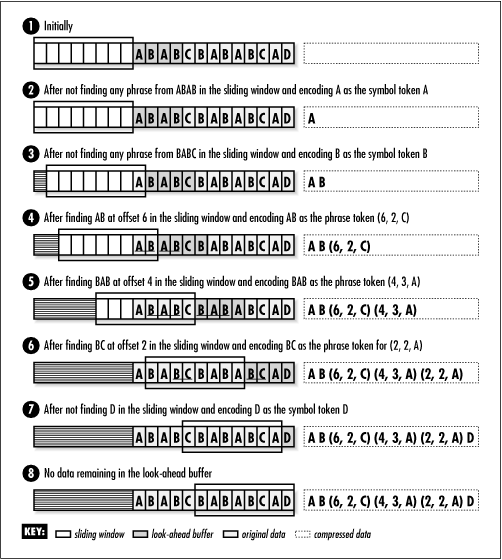Description of LZ77
LZ77 ( Lempel-Ziv-1977) is a simple but surprisingly effective form of data compression that takes an entirely different approach from Huffman coding. LZ77 is a dictionary-based method, which means that it tries to compress data by encoding long strings of symbols, called phrases, as small tokens that reference entries in a dictionary. Compression is achieved by using relatively small tokens in place of longer phrases that appear several times in the data. As with Huffman coding, it is important to realize that a symbol is not necessarily a character of text: a symbol can be any amount of data we choose, but it is often one byte’s worth.
Maintaining a Dictionary of Phrases
Different dictionary-based compression methods use various approaches for maintaining their dictionaries. LZ77 uses a look-ahead buffer and a sliding window . LZ77 works by first loading a portion of the data into the look-ahead buffer. To understand how the look-ahead buffer stores phrases that effectively form a dictionary, picture the buffer as a sequence of symbols s 1, . . . , sn , and Pb as a set of phrases constructed from the symbols. From the sequence s 1, . . . , sn , we form n phrases, defined as:
Pb = {(s1), (s1, s2), . . . ,(s1, . . . ,sn )}
This means that if the look-ahead buffer contains the symbols (A, B, D), for example, the phrases in the buffer are {(A), (A, B), (A, B, D)}. Once data passes through the look-ahead buffer, it moves into the sliding window and becomes part of the dictionary. To understand how phrases are represented in the sliding window, consider the window to be a sequence of symbols s 1, . . ., sm , and Pw to be a set of phrases constructed from these symbols. From the sequence s 1, . . ., sm , we form the set of phrases as follows:
Pw = {p1, p2, . . . , pm}, where pi = {(si), (si, si+1), . . . , si, si+1, . . . , sm)}
Thus, if the sliding window contains the symbols (A, B, C), the phrases in the window, and hence the dictionary, are {(A), (A, B), (A, B, C), (B), (B, C), (C)}. The main idea behind LZ77 is to look continually for the longest phrase in the look-ahead buffer that matches a phrase currently in the dictionary. In the look-ahead buffer and sliding window just described, the longest match is the two-symbol phrase (A, B).
Compressing and Uncompressing Data
As we compress the data, two situations can exist between the look-ahead buffer and the sliding window at any given moment: there can either be a phrase of some length that matches, or there may be no match at all. When there is at least one match, we encode the longest match as a phrase token . Phrase tokens contain three pieces of information: the offset in the sliding window where the match begins, the number of symbols in the match, and the first symbol in the look-ahead buffer after the match. When there is no match, we encode the unmatched symbol as a symbol token . Symbol tokens simply contain the unmatched symbol itself, so no compression is accomplished. In fact, we will see that symbol tokens actually contain one bit more than the symbol itself, so a slight expansion occurs.
Once the appropriate token has been generated that encodes some number of symbols n, we shift n symbols out one end of the sliding window and replace them at the other end by the same number of symbols shifted out of the look-ahead buffer. Next, we refill the look-ahead buffer. This process keeps the sliding window up to date with only the most recent phrases. The exact number of phrases maintained by the sliding window and look-ahead buffer depends on their size.
Figure 14.2 illustrates the compression of a string using LZ77 with a sliding window of 8 bytes and a look-ahead buffer of 4 bytes. In practice, typical sizes for sliding windows are around 4K (4096 bytes). Look-ahead buffers are generally less than 100 bytes.
We uncompress data by decoding tokens and keeping the sliding window updated in a manner analogous to the compression process. As we decode each token, we copy the symbols that the token encodes into the sliding window. Whenever we encounter a phrase token, we consult the appropriate offset in the sliding window and look up the phrase of the specified length that we find there. Whenever we encounter a symbol token, we generate the single symbol stored in the token itself. Figure 14.3 illustrates uncompressing the data compressed in Figure 14.2.
Effectiveness of LZ77
The amount of compression achieved using LZ77 depends on a number of factors, such as the size chosen for the sliding window, the size set for the look-ahead buffer, and the entropy of the data itself. Ultimately, the amount of compression depends on the number of phrases we are able to match and their lengths. In most cases, LZ77 results in better compression ratios than Huffman coding, but compression times are considerably slower.
Compressing data with LZ77 is time-consuming because we spend a lot of time searching the sliding window for matching phrases. However, in general, uncompressing data with LZ77 is even faster than ucompressing data with Huffman coding. Uncompressing data with LZ77 is fast because each token tells us exactly where to read symbols out of the buffer. In fact, we end up reading from the sliding window only as many symbols as in the original data.


